Monitoring Neuromuscular Performance in Military Personnel
Abstract
1. Introduction
2. Defining Ground Reaction Forces
3. Force Plate Functions
4. The Force-Time Curve Explained
4.1. Importance of Measuring Body Weight
4.2. Identifying the Onset of Movement or Distinction of Phases
4.3. Integrating the Force-Time Curve
5. The Force-Time Curve Considerations
5.1. Selecting the Right Variables
5.2. Reliable Metrics and Reliability Testing
5.3. Conducting Multiple Versus Single Trials
6. Standardized and Validated Tests for Force Plates
6.1. Lower Body Power Testing
6.1.1. Countermovement or Squat Jump (CMJ or SJ)
| Metric | Definition | CMJ | SJ | DJ | Depth Drop |
|---|---|---|---|---|---|
| Performance Metrics | |||||
| Jump Height | Greatest center of mass vertical displacement during flight (cm). Calculated using flight time or impulse-momentum theorum. | Y | Y | Y | |
| RSI | Ratio between jump height (or flight time) and initial ground contact time (arbitrary units). | Y | |||
| RSImod | Ratio between jump height and time to take-off [78]. | Y | |||
| Time to Stabilization | Time from the landing point to the period of stabilization (vertical forces reach and stay within 5.0% or 5 SD of body weight for 1-second) (s). | Y | |||
| Explanatory Force-Time Curve Metrics | |||||
| Contact Time | Duration from initial ground contact to take-off (s). | Y | |||
| Countermovement Depth | Maximal vertical center of mass displacement during initial ground contact (cm). | Y | Y | Y | Y |
| Braking Duration | Duration of the braking phase (s). | Y | Y | ||
| Braking Mean Force | Mean force of the braking phase (N) | Y | Y | ||
| Braking Impulse | Area under the braking phase of the net force-time curve (N×). | Y | Y | ||
| Propulsive Duration: | Duration of the propulsive phase (s). | Y | Y | Y | |
| Propulsive Mean Force | Mean force of the propulsive phase (N) | Y | Y | ||
| Propulsive Impulse | Area under the propulsive phase of the net force-time curve (N×s). | Y | Y | Y | |
| Mean Propulsive Power | Propulsive phase’s average power output (W). | Y | Y | Y | |
| Braking Velocity | Braking phase’s mean or peak (m·s−1) | Y | Y | ||
| Peak Landing Force | Peak force occurred during the landing phase (N). | Y | Y | ||
| Peak Landing Force Timing | Time of peak landing force relative contact time (s). | Y | Y | ||
| Metrics to Use with Caution | |||||
| Rate of Force Development | The change in force over time (i.e., force-time curve slope). Using time epochs (i.e., 0–250 milliseconds) are preferred, as well as internal, routine reliability assessments. | ||||
| Propulsive Phase or Total Peak Power | Amount of work performed over time. With high sampling rates (i.e., 1000 Hz), peak power describes a very short time period (i.e., 1 millisecond) and may be variable (sensitive to artifact). | ||||
6.1.2. Drop Jump/Depth Jump/Depth Drop
6.2. Lower-Body Strength Testing: Isometric Mid-Thigh Pull and Squat
6.3. Upper Body Isometric Strength Testing
6.4. Upper Body Plyometrics
6.5. Limb Assymetries
6.6. Balance Assessments
| Movement | Reliable Metrics | Tactical Relevance |
|---|---|---|
|
|
|
|
|
|
|
|
|
|
|
|
|
|
|
|
|
|
|
|
|
|
|
|
7. Conclusions
Author Contributions
Funding
Conflicts of Interest
References
- Nindl, B.C.; Alvar, B.A.; Dudley, J.R.; Favre, M.W.; Martin, G.J.; Sharp, M.A.; Warr, B.J.; Stephenson, M.D.; Kraemer, W.J. Executive summary from the National Strength and Conditioning Association’s Second Blue Ribbon Panel on Military Physical Readiness: Military physical performance testing. J. Strength Cond. Res. 2015, 29, S216–S220. [Google Scholar] [CrossRef] [PubMed]
- Ruble, P.; Silverman, M.; Harrell, J.; Ringenberg, L.; Fruendt, J.; Walters, T.; Christiansen, L.; Llorente, M.; Barnett, S.D.; Scherb, B.; et al. Medical and physical readiness of the U.S. Army Reserve for Noble Eagle/Enduring Freedom/Iraqi Freedom: Recommendations for future mobilizations. Mil. Med. 2005, 170, 443–450. [Google Scholar] [CrossRef] [PubMed][Green Version]
- Hauschild, V.D.; De Groot, D.W.; Hall, S.M.; Grier, T.L.; Deaver, K.D.; Hauret, K.G.; Jones, B.H. Fitness tests and occupational tasks of military interest: A systematic review of correlations. Occup. Environ. Med. 2017, 74, 144–153. [Google Scholar] [CrossRef] [PubMed]
- Bullock, S.H.; Jones, B.H.; Gilchrist, J.; Marshall, S.W. Prevention of physical training–related injuries: Recommendations for the Military and other active populations based on expedited systematic reviews. Am. J. Prev. Med. 2010, 38, S156–S181. [Google Scholar] [CrossRef]
- McGuigan, M. Monitoring Training and Performance in Athletes; Human Kinetics: Champaign, IL, USA, 2017; ISBN 1-4925-3520-6. [Google Scholar]
- Cunanan, A.J.; De Weese, B.H.; Wagle, J.P.; Carroll, K.M.; Sausaman, R.; Hornsby, W.G.; Haff, G.G.; Triplett, N.T.; Pierce, K.C.; Stone, M.H. The General Adaptation Syndrome: A foundation for the concept of periodization. Sports Med. 2018, 48, 787–797. [Google Scholar] [CrossRef]
- Selye, H. The general adaptation syndrome and the diseases of adaptation. J. Clin. Endocrinol. 1946, 6, 117–230. [Google Scholar] [CrossRef]
- Maupin, D.; Schram, B.; Orr, R. Tracking training load and its implementation in tactical populations: A narrative review. Strength Cond. J. 2019, 41, 1–11. [Google Scholar] [CrossRef]
- Knapik, J.J.; Graham, B.S.; Rieger, J.; Steelman, R.; Pendergrass, T. Activities associated with injuries in initial entry training. Mil. Med. 2013, 178, 500–506. [Google Scholar] [CrossRef]
- Kelly, E.W.; Bradway, L.F. A team approach to the treatment of musculoskeletal injuries suffered by Navy recruits: A method to decrease attrition and improve quality of care. Mil. Med. 1997, 162, 354–359. [Google Scholar] [CrossRef][Green Version]
- Kaufman, K. Military training-related injuries surveillance, research, and prevention. Am. J. Prev. Med. 2000, 18, 54–63. [Google Scholar] [CrossRef]
- Jones, B.H.; Cowan, D.N.; Tomlison, J.P.; Robinson, J.R.; Polly, D.W.; Frykman, P.N. Epidemiology of injuries associated with physical training among young men in the army. Med. Sci. Sports Exerc. 1993, 25, 197–203. [Google Scholar] [CrossRef]
- Knapik, J.J.; Reynolds, K. Load carriage-related injury mechanisms, risk factors, and prevention. In The Mechanobiology and Mechanophysiology of Military-Related Injuries; Gefen, A., Epstein, Y., Eds.; Studies in Mechanobiology, Tissue Engineering and Biomaterials; Springer International Publishing: Berlin/Heidelberg, Germany, 2016; pp. 107–137. ISBN 978-3-319-33012-9. [Google Scholar]
- Orr, R.M.; Johnston, V.; Coyle, J.; Pope, R. Reported load carriage injuries of the Australian Army Soldier. J. Occup. Rehabil. 2015, 25, 316–322. [Google Scholar] [CrossRef] [PubMed]
- Shaffer, R.A.; Brodine, S.K.; Ito, S.I.; Le, A.T. Epidemiology of illness and injury among U.S. Navy and Marine Corps female training populations. Mil. Med. 1999, 164, 17–21. [Google Scholar] [CrossRef] [PubMed]
- Dijksma, C.I.; Bekkers, M.; Spek, B.; Lucas, C.; Stuiver, M. Epidemiology and financial burden of musculoskeletal injuries as the leading health problem in the military. Mil. Med. 2020, 185, e480–e486. [Google Scholar] [CrossRef] [PubMed]
- Andersen, K.A.; Grimshaw, P.N.; Kelso, R.M.; Bentley, D.J. Musculoskeletal lower limb injury risk in Army populations. Sports Med. Open 2016, 2, 22. [Google Scholar] [CrossRef]
- Wardle, S.L.; Greeves, J.P. Mitigating the risk of musculoskeletal injury: A systematic review of the most effective injury prevention strategies for military personnel. J. Sci. Med. Sport 2017, 20, S3–S10. [Google Scholar] [CrossRef] [PubMed]
- Fortes, M.B.; Diment, B.C.; Greeves, J.P.; Casey, A.; Izard, R.; Walsh, N.P. Effects of a daily mixed nutritional supplement on physical performance, body composition, and circulating anabolic hormones during 8 weeks of arduous military training. Appl. Physiol. Nutr. Metab. 2011, 36, 967–975. [Google Scholar] [CrossRef]
- Hoffman, J.R.; Landau, G.; Stout, J.R.; Dabora, M.; Moran, D.S.; Sharvit, N.; Hoffman, M.W.; Ben Moshe, Y.; McCormack, W.P.; Hirschhorn, G.; et al. β-alanine supplementation improves tactical performance but not cognitive function in combat soldiers. J. Int. Soc. Sports Nutr. 2014, 11, 15. [Google Scholar] [CrossRef] [PubMed]
- Loturco, I.; Ugrinowitsch, C.; Roschel, H.; Lopes Mellinger, A.; Gomes, F.; Tricoli, V.; Gonzáles-Badillo, J.J. Distinct temporal organizations of the strength- and power-training loads produce similar performance improvements. J. Strength Cond. Res. 2013, 27, 188–194. [Google Scholar] [CrossRef]
- Nindl, B.C.; Barnes, B.R.; Alemany, J.A.; Frykman, P.N.; Shippee, R.L.; Friedl, K.E. Physiological consequences of U.S. Army Ranger Training. Med. Sci. Sports Exerc. 2007, 39, 1380–1387. [Google Scholar] [CrossRef]
- Welsh, T.; Alemany, J.; Montain, S.; Frykman, P.; Tuckow, A.; Young, A.; Nindl, B. Effects of intensified Military field training on jumping performance. Int. J. Sports Med. 2008, 29, 45–52. [Google Scholar] [CrossRef] [PubMed]
- MAUPIN, D.; WILLS, T.; ORR, R.; SCHRAM, B. Fitness profiles in elite tactical units: A critical review. Int. J. Exerc. Sci. 2018, 11, 1041–1062. [Google Scholar] [PubMed]
- Moreno, M.R.; Dulla, J.M.; Dawes, J.J.; Orr, R.M.; Cesario, A.; Lockie, R.G. Lower-body power and its relationship with body drag velocity in law enforcement recruits. Int. J. Exerc. Sci. 2019, 12, 847–858. [Google Scholar]
- Joseph, A.; Wiley, A.; Orr, R.; Schram, B.; Dawes, J.J. The impact of load carriage on measures of power and agility in tactical occupations: A critical review. Int. J. Environ. Res. Public Health 2018, 15, 88. [Google Scholar] [CrossRef]
- Orr, R.M.; Dawes, J.J.; Lockie, R.G.; Godeassi, D.P. The Relationship between lower-body strength and power, and load carriage tasks: A critical review. Int. J. Exerc. Sci. 2019, 12, 1001–1022. [Google Scholar]
- Šimenko, J.; Kovcan, B.; Pori, P.; Vodicar, J.; Vodicar, M.; Hadžic, V. The relationship between Army physical fitness and functional capacities in infantry members of the Slovenian Armed Forces. J. Strength Cond. Res. 2020. Publish Ahead of Print. [Google Scholar] [CrossRef]
- Schram, B.; Robinson, J.; Orr, R. The Physical Fitness Effects of a week-long specialist tactical police selection course. Int. J. Environ. Res. Public Health 2020, 17, 6782. [Google Scholar] [CrossRef]
- Owens, B.D.; Cameron, K.L.; Duffey, M.L.; Vargas, D.; Duffey, M.J.; Mountcastle, S.B.; Padua, D.; Nelson, B.J. Military movement training program improves jump-landing mechanics associated with anterior cruciate ligament injury risk. J. Surg. Orthop. Adv. 2013, 22, 66–70. [Google Scholar] [CrossRef]
- Pihlainen, K.; Santtila, M.; Häkkinen, K.; Kyröläinen, H. Associations of physical fitness and body composition characteristics with simulated military task performance. J. Strength Cond. Res. 2018, 32, 1089–1098. [Google Scholar] [CrossRef]
- Groeller, H.; Burley, S.; Orchard, P.; Sampson, J.A.; Billing, D.C.; Linnane, D. How effective is initial military-specific training in the development of physical performance of soldiers? J. Strength Cond. Res. 2015, 29, S158. [Google Scholar] [CrossRef]
- Lockie, R.G.; Dawes, J.J.; Balfany, K.; Gonzales, C.E.; Beitzel, M.M.; Dulla, J.M.; Orr, R.M. Physical fitness characteristics that relate to Work Sample Test Battery performance in law enforcement recruits. Int. J. Environ. Res. Public Health 2018, 15, 2477. [Google Scholar] [CrossRef] [PubMed]
- Mala, J.; Szivak, T.K.; Flanagan, S.D.; Comstock, B.A.; Laferrier, J.Z.; Maresh, C.M.; Kraemer, W.J. The role of strength and power during performance of high intensity military tasks under heavy load carriage. US Army Med. Dep. J. 2015, 3–11. Available online: https://www.researchgate.net/publication/279308669_The_Role_of_Strength_and_Power_During_Performance_of_High_Intensity_Military_Tasks_Under_Heavy_Load_Carriage (accessed on 30 October 2020).
- Taylor, K.-L.; Chapman, D.W.; Cronin, J.B.; Newton, M.J.; Gill, N. Fatigue monitoring in high performance sport: A survey of current trends. J. Aust. Strength Cond. 2012, 20, 12. [Google Scholar]
- Wu, P.P.-Y.; Sterkenburg, N.; Everett, K.; Chapman, D.W.; White, N.; Mengersen, K. Predicting fatigue using countermovement jump force-time signatures: PCA can distinguish neuromuscular versus metabolic fatigue. PLoS ONE 2019, 14, e0219295. [Google Scholar] [CrossRef] [PubMed]
- Ortega, D.R.; Rodríguez Bíes, E.C.; de la Rosa, F.J.B. Analysis of the vertical ground reaction forces and temporal factors in the landing phase of a countermovement jump. J. Sports Sci. Med. 2010, 9, 282–287. [Google Scholar] [PubMed]
- Kennedy, R.; Drake, D. The effect of acute fatigue on countermovement jump performance in rugby union players during preseason. J. Sports Med. Phys. Fit. 2017, 57, 1261–1266. [Google Scholar]
- Street, G.; McMillan, S.; Board, W.; Rasmussen, M.; Heneghan, J.M. Sources of error in determining countermovement jump height with the impulse method. J. Appl. Biomech. 2001, 17, 43–54. [Google Scholar] [CrossRef]
- McLean, B.D.; Coutts, A.J.; Kelly, V.; McGuigan, M.R.; Cormack, S.J. Neuromuscular, endocrine, and perceptual fatigue responses during different length between-match microcycles in professional rugby league players. Int. J. Sports Physiol. Perform. 2010, 5, 367–383. [Google Scholar] [CrossRef]
- Mooney, M.G.; Cormack, S.; O’Brien, B.J.; Morgan, W.M.; McGuigan, M. Impact of neuromuscular fatigue on match exercise intensity and performance in elite Australian football. J. Strength Cond. Res. 2013, 27, 166–173. [Google Scholar] [CrossRef]
- Brady, C.J.; Harrison, A.J.; Comyns, T.M. A review of the reliability of biomechanical variables produced during the isometric mid-thigh pull and isometric squat and the reporting of normative data. Null 2020, 19, 1–25. [Google Scholar] [CrossRef]
- Comfort, P.; Jones, P.A.; McMahon, J.J.; Newton, R. Effect of knee and trunk angle on kinetic variables during the isometric midthigh pull: Test–retest reliability. Int. J. Sports Physiol. Perform. 2015, 10, 58–63. [Google Scholar] [CrossRef] [PubMed]
- Merrigan, J.J.; Dabbs, N.C.; Jones, M.T. Isometric mid-thigh pull kinetics: Sex differences and response to whole-body vibration. J. Strength Cond. Res. 2020, 34(9), 2407–2411. [Google Scholar] [CrossRef] [PubMed]
- Newtoni, I. Philosophiae Naturalis Principia Mathematica.-Londoni: Jussu Societatis Regiae ac Typis Josephi Streater, 1687; Dawson: London, UK, 1954; 510p. [Google Scholar]
- Oliver, G.D.; Stone, A.; Booker, J.; Plummer, H. A Kinematic and kinetic analysis of drop landings in military boots. J. Royal Army Med. Corps 2011, 157, 218–221. [Google Scholar] [CrossRef] [PubMed]
- Sell, T.C.; Chu, Y.; Abt, J.P.; Nagai, T.; Deluzio, J.; McGrail, M.A.; Rowe, R.S.; Lephart, S.M. Minimal additional weight of combat equipment alters air assault Soldiers’ landing biomechanics. Mil. Med. 2010, 175, 41–47. [Google Scholar] [CrossRef] [PubMed]
- Dempsey, P.C.; Handcock, P.J.; Rehrer, N.J. Body armour: The effect of load, exercise and distraction on landing forces. J. Sports Sci. 2014, 32, 301–306. [Google Scholar] [CrossRef]
- Dai, B.; Cook, R.F.; Meyer, E.A.; Sciascia, Y.; Hinshaw, T.J.; Wang, C.; Zhu, Q. The effect of a secondary cognitive task on landing mechanics and jump performance. Sports Biomech. 2018, 17, 192–205. [Google Scholar] [CrossRef]
- Chu, Y.; Sell, T.C.; Abt, J.P.; Nagai, T.; Deluzio, J.; McGrail, M.; Rowe, R.; Smalley, B.; Lephart, S.M. Air Assault Soldiers demonstrate more dangerous landing biomechanics when visual input is removed. Mil. Med. 2012, 177, 41–47. [Google Scholar] [CrossRef][Green Version]
- Kleckers, T. Piezoelectric or Strain Gauge Based Force Transducers? Available online: https://www.hbm.com/en/3719/piezoelectric-or-strain-gauge-based-force-transducers/ (accessed on 23 September 2020).
- Bartlett, R. Introduction to Sports Biomechanics: Analysing Human Movement Patterns, 2nd ed.; Routledge: London, UK, 2007; ISBN 978-0-203-46202-7. [Google Scholar]
- Dos’Santos, T.; Jones, P.A.; Comfort, P.; Thomas, C. Effect of different onset thresholds on isometric midthigh pull force-time variables. J. Strength Cond. Res. 2017, 31, 3463–3473. [Google Scholar] [CrossRef]
- Hall, M.G.; Fleming, H.E.; Dolan, M.J.; Millbank, S.F.D.; Paul, J.P. Static in situ calibration of force plates. J. Biomech. 1996, 29, 659–665. [Google Scholar] [CrossRef]
- Bobbert, M.F.; Schamhardt, H.C. Accuracy of determining the point of force application with piezoelectric force plates. J. Biomech. 1990, 23, 705–710. [Google Scholar] [CrossRef]
- Middleton, J.; Sinclair, P.; Patton, R. Accuracy of centre of pressure measurement using a piezoelectric force platform. Clin. Biomech. 1999, 14, 357–360. [Google Scholar] [CrossRef]
- Chockalingam, N.; Giakas, G.; Iossifidou, A. Do strain gauge force platforms need in situ correction? Gait Posture 2002, 16, 233–237. [Google Scholar] [CrossRef]
- Chavda, S.; Bromley, T.; Jarvis, P.; Williams, S.; Bishop, C.; Turner, A.N.; Lake, J.P.; Mundy, P.D. Force-Time Characteristics of the Countermovement Jump: Analyzing the Curve in Excel. Strength Cond. J. 2018, 40, 67–77. [Google Scholar] [CrossRef]
- Beckham, G.; Suchomel, T.; Mizuguchi, S. Force plate use in performance monitoring and sport science testing. New Stud. Athl. 2014, 29, 25–37. [Google Scholar]
- Stone, M.H.; Moir, G.; Glaister, M.; Sanders, R. How much strength is necessary? Phys. Ther. Sport 2002, 3, 88–96. [Google Scholar] [CrossRef]
- McMahon, J.J.; Suchomel, T.J.; Lake, J.P.; Comfort, P. Understanding the Key Phases of the Countermovement Jump Force-Time Curve. Strength Cond. J. 2018, 40, 96–106. [Google Scholar] [CrossRef]
- Vanrenterghem, J.; De Clercq, D.; Cleven, P.V. Necessary precautions in measuring correct vertical jumping height by means of force plate measurements. Ergonomics 2001, 44, 814–818. [Google Scholar] [CrossRef]
- Owen, N.J.; Watkins, J.; Kilduff, L.P.; Bevan, H.R.; Bennett, M.A. Development of a Criterion Method to Determine Peak Mechanical Power Output in a Countermovement Jump. J. Strength Cond. Res. 2014, 28, 1552–1558. [Google Scholar] [CrossRef]
- Linthorne, N.P. Analysis of standing vertical jumps using a force platform. Am. J. Phys. 2001, 69, 1198–1204. [Google Scholar] [CrossRef]
- Newton, R.U.; Young, W.B.; Kraemer, W.J.; Byrne, C. Effects of drop jump height and technique on ground reaction force with possible implication for injury. Sports Med. Train. Rehabil. 2001, 10, 83–93. [Google Scholar] [CrossRef]
- Walsh, M.; Arampatzis, A.; Schade, F.; Brüggemann, G.-P. The Effect of Drop Jump Starting Height and Contact Time on Power, Work Performed, and Moment of Force. J. Strength Cond. Res. 2004, 18, 561–566. [Google Scholar] [PubMed]
- Moir, G.L. Three Different Methods of Calculating Vertical Jump Height from Force Platform Data in Men and Women. Meas. Phys. Educ. Exerc. Sci. 2008, 12, 207–218. [Google Scholar] [CrossRef]
- Mizuguchi, S.; Sands, W.A.; Wassinger, C.A.; Lamont, H.S.; Stone, M.H. A new approach to determining net impulse and identification of its characteristics in countermovement jumping: Reliability and validity. Sports Biomech. 2015, 14, 258–272. [Google Scholar] [CrossRef] [PubMed]
- Hornsby, W.G.; Gentles, J.A.; MacDonald, C.J.; Mizuguchi, S.; Ramsey, M.W.; Stone, M.H. Maximum strength, rate of force development, jump height, and peak power alterations in weightlifters across five months of training. Sports 2017, 5, 78. [Google Scholar] [CrossRef]
- Norris, D.; Joyce, D.; Siegler, J.; Clock, J.; Lovell, R. Recovery of Force–Time Characteristics After Australian Rules Football Matches: Examining the Utility of the Isometric Midthigh Pull. Int. J. Sports Physiol. Perform. 2019, 14, 765–770. [Google Scholar] [CrossRef]
- Hopkins, W.G. Spreadsheets for analysis of validity and reliability. Sport Sci. 2017, 21, 36–44. [Google Scholar]
- Hopkins, W.G. Measures of Reliability in Sports Medicine and Science. Sports Med. 2000, 30, 1–15. [Google Scholar] [CrossRef]
- Claudino, J.G.; Cronin, J.; Mezêncio, B.; McMaster, D.T.; McGuigan, M.; Tricoli, V.; Amadio, A.C.; Serrão, J.C. The countermovement jump to monitor neuromuscular status: A meta-analysis. J. Sci. Med. Sport 2017, 20, 397–402. [Google Scholar] [CrossRef]
- Haddad, H.A.; Simpson, B.M.; Buchheit, M. Monitoring Changes in Jump and Sprint Performance: Best or Average Values? Int. J. Sports Physiol. Perform. 2015, 10, 931–934. [Google Scholar] [CrossRef]
- Weir, J.P. Quantifying test-retest reliability using the intraclass correlation coefficient and the SEM. J. Strength Cond. Res. 2005, 19, 231–240. [Google Scholar]
- Oliver, J.; Armstrong, N.; Williams, C. Changes in jump performance and muscle activity following soccer-specific exercise. J. Sports Sci. 2008, 26, 141–148. [Google Scholar] [CrossRef] [PubMed]
- Gathercole, R.J.; Sporer, B.C.; Stellingwerff, T.; Sleivert, G.G. Comparison of the Capacity of Different Jump and Sprint Field Tests to Detect Neuromuscular Fatigue. J. Strength Cond. Res. 2015, 29, 2522–2531. [Google Scholar] [CrossRef] [PubMed]
- Ebben, W.P.; Petushek, E.J. Using the Reactive Strength Index Modified to Evaluate Plyometric Performance. J. Strength Cond. Res. 2010, 24, 1983–1987. [Google Scholar] [CrossRef] [PubMed]
- Bosco, C.; Komi, P.V.; Tihanyi, J.; Fekete, G.; Apor, P. Mechanical power test and fiber composition of human leg extensor muscles. Eur. J. Appl. Physiol. 1983, 51, 129–135. [Google Scholar] [CrossRef]
- Dal Pupo, J.; Gheller, R.G.; Dias, J.A.; Rodacki, A.L.F.; Moro, A.R.P.; Santos, S.G. Reliability and validity of the 30-s continuous jump test for anaerobic fitness evaluation. J. Sci. Med. Sport 2014, 17, 650–655. [Google Scholar] [CrossRef] [PubMed]
- Mohr, M.; Mujika, I.; Santisteban, J.; Randers, M.B.; Bischoff, R.; Solano, R.; Hewitt, A.; Zubillaga, A.; Peltola, E.; Krustrup, P. Examination of fatigue development in elite soccer in a hot environment: A multi-experimental approach. Scand. J. Med. Sci. Sports 2010, 20, 125–132. [Google Scholar] [CrossRef]
- Stratford, C.; Dos’Santos, T.; McMahon, J. A Comparison Between the Drop Jump and 10/5 Repeated Jumps Test to Measure the Reactive Strength Index. Summer 2020, 2020, 23–28. [Google Scholar]
- Struzik, A.; Juras, G.; Pietraszewski, B.; Rokita, A. Effect of drop jump technique on the reactive strength index. J. Hum. Kinet. 2016, 52, 157–164. [Google Scholar] [CrossRef]
- Behm, D.G.; Sale, D.G. Intended rather than actual movement velocity determines velocity-specific training response. J. Appl. Physiol. 1993, 74, 359–368. [Google Scholar] [CrossRef]
- Suchomel, T.J.; Nimphius, S.; Stone, M.H. The Importance of Muscular Strength in Athletic Performance. Sports Med. 2016, 46, 1419–1449. [Google Scholar] [CrossRef]
- Beckham, G.K.; Lamont, H.S.; Sato, K.; Ramsey, M.W.; Gregory Haff, G.; Stone, M.H. Isometric Strength of Powerlifters in Key Positions of the Conventional Deadlift. J. Trainol. 2012, 1, 32–35. [Google Scholar] [CrossRef]
- Beckham, G.; Mizuguchi, S.; Carter, C.; Sato, K.; Ramsey, M.; Lamont, H.; Hornsby, G.; Haff, G.; Stone, M. Relationships of isometric mid-thigh pull variables to weightlifting performance. J. Sports Med. Phys. Fit. 2013, 53, 573–581. [Google Scholar]
- Slawinski, J.; Bonnefoy, A.; Levèque, J.-M.; Ontanon, G.; Riquet, A.; Dumas, R.; Chèze, L. Kinematic and Kinetic Comparisons of Elite and Well-Trained Sprinters During Sprint Start. J. Strength Cond. Res. Champaign 2010, 24, 896–905. [Google Scholar] [CrossRef] [PubMed]
- Haff, G.G.; Stone, M.; OʼBryant, H.S.; Harman, E.; Dinan, C.; Johnson, R.; Han, K.-H. Force-Time Dependent Characteristics of Dynamic and Isometric Muscle Actions. J. Strength Cond. Res. 1997, 11, 269–272. [Google Scholar] [CrossRef]
- Buckner, S.L.; Jessee, M.B.; Mattocks, K.T.; Mouser, J.G.; Counts, B.R.; Dankel, S.J.; Loenneke, J.P. Determining strength: A case for multiple methods of measurement. Sports Med. 2017, 47, 193–195. [Google Scholar] [CrossRef]
- Bazyler, C.D.; Beckham, G.K.; Sato, K. The Use of the Isometric Squat as a Measure of Strength and Explosiveness. J. Strength Cond. Res. 2015, 29, 1386–1392. [Google Scholar] [CrossRef]
- Comfort, P.; Dos’Santos, T.; Beckham, G.K.; Stone, M.H.; Guppy, S.N.; Haff, G.G. Standardization and Methodological Considerations for the Isometric Midthigh Pull. Strength Cond. J. 2019, 41, 57–79. [Google Scholar] [CrossRef]
- Murphy, A.J.; Wilson, G.J.; Pryor, J.F.; Newton, R.U. Isometric Assessment of Muscular Function: The Effect of Joint Angle. J. Appl. Biomech. 1995, 11, 205–215. [Google Scholar] [CrossRef][Green Version]
- Young, K.P.; Haff, G.G.; Newton, R.U.; Sheppard, J.M. Reliability of a Novel Testing Protocol to Assess Upper-Body Strength Qualities in Elite Athletes. Int. J. Sports Physiol. Perform. 2014, 9, 871–875. [Google Scholar] [CrossRef]
- Lum, D.; Aziz, L. Validity and Reliability of the Isometric Prone Bench Pull Test. Int. J. Sports Med. 2020, 41, 520–527. [Google Scholar] [CrossRef]
- Merrigan, J.; Burke, A.; Fyock-Martin, M.; Martin, J. What factors predict upper body push to pull ratios in professional Firefighters? Int. J. Exerc. Sci. 2020, 13, 1605–1614. [Google Scholar]
- Hogarth, L.; Deakin, G.; Sinclair, W. Are plyometric push-ups a reliable power assessment tool? J. Aust. Strength Cond. 2013, 21, 67–69. [Google Scholar]
- Jones, M.T.; Oliver, J.M.; Delgado, J.C.; Merrigan, J.J.; Jagim, A.R.; Robison, C.E. Effect of acute complex training on upper-body force and power in collegiate wrestlers. J. Strength Cond. Res. 2019, 33, 902–909. [Google Scholar] [CrossRef] [PubMed]
- Koch, J.; Riemann, B.L.; Davies, G.J. Ground reaction force patterns in plyometric push-ups. J. Strength Cond. Res. 2012, 26, 2220–2227. [Google Scholar] [CrossRef]
- Stockbrugger, B.A.; Haennel, R.G. Contributing factors to performance of a medicine ball explosive power test: A comparison between jump and nonjump athletes. J. Strength Cond. Res. 2003, 17, 768–774. [Google Scholar] [CrossRef]
- Parry, G.N.; Herrington, L.C.; Horsley, I.G. The test–retest reliability of force plate–derived parameters of the countermovement push-up as a power assessment tool. J. Sport Rehabil. 2020, 29, 381–383. [Google Scholar] [CrossRef]
- Devita, P.; Skelly, W.A. Effect of landing stiffness on joint kinetics and energetics in the lower extremity. Med. Sci. Sports Exerc. 1992, 24, 108–115. [Google Scholar] [CrossRef]
- Nicol, C.; Avela, J.; Komi, P.V. The stretch-shortening cycle: A model to study naturally occurring neuromuscular fatigue. Sports Med. 2006, 36, 977–999. [Google Scholar] [CrossRef]
- Lenetsky, S.; Harris, N.; Brughelli, M. Assessment and contributors of punching forces in combat sports athletes: Implications for strength and conditioning. Strength Cond. J. 2013, 35, 1–7. [Google Scholar] [CrossRef]
- Smith, M.S.; Dyson, R.J.; Hale, T.; Janaway, L. Development of a boxing dynamometer and its punch force discrimination efficacy. J. Sports Sci. 2000, 18, 445–450. [Google Scholar] [CrossRef]
- Dai, B.; Butler, R.J.; Garrett, W.E.; Queen, R.M. Using ground reaction force to predict knee kinetic asymmetry following anterior cruciate ligament reconstruction: Knee kinetic asymmetry. Scand.J Med. Sci. Sports 2014, 24, 974–981. [Google Scholar] [CrossRef] [PubMed]
- Paterno, M.V.; Ford, K.R.; Myer, G.D.; Heyl, R.; Hewett, T.E. Limb Asymmetries in landing and jumping 2 years following anterior cruciate ligament reconstruction. Clin. J. Sport Med. 2007, 17, 258–262. [Google Scholar] [CrossRef] [PubMed]
- Maloney, S.J.; Richards, J.; Nixon, D.G.D.; Harvey, L.J.; Fletcher, I.M. Do stiffness and asymmetries predict change of direction performance? J. Sports Sci. 2017, 35, 547–556. [Google Scholar] [CrossRef] [PubMed]
- Hewett, T.E.; Myer, G.D.; Ford, K.R.; Paterno, M.V.; Quatman, C.E. Mechanisms, prediction, and prevention of ACL injuries: Cut risk with three sharpened and validated tools. J. Orthop. Res. 2016, 34, 1843–1855. [Google Scholar] [CrossRef]
- Bishop, C.; Turner, A.; Read, P. Effects of inter-limb asymmetries on physical and sports performance: A systematic review. J. Sports Sci. 2018, 36, 1135–1144. [Google Scholar] [CrossRef]
- Flanagan, E.P.; Ebben, W.P.; Jensen, R.L. Reliability of the Reactive Strength Index and Time to Stabilization during Depth Jumps. J. Strength Cond. Res. 2008, 22, 1677–1682. [Google Scholar] [CrossRef]
- Webster, K.A.; Gribble, P.A. Time to Stabilization of Anterior Cruciate Ligament–Reconstructed Versus Healthy Knees in National Collegiate Athletic Association Division I Female Athletes. J. Athl. Train 2010, 45, 580–585. [Google Scholar] [CrossRef]
- Gribble, P.A.; Mitterholzer, J.; Myers, A.N. Normalizing considerations for time to stabilization assessment. J. Sci. Med. Sport 2012, 15, 159–163. [Google Scholar] [CrossRef]
- Gera, G.; Chesnutt, J.; Mancini, M.; Horak, F.B.; King, L.A. Inertial Sensor-Based Assessment of Central Sensory Integration for Balance after Mild Traumatic Brain Injury. Mil. Med. 2018, 183, 327–332. [Google Scholar] [CrossRef]
- Walker, W.; Nowak, K.; Kenney, K.; Franke, L.; Eapen, B.; Skop, K.; Levin, H.; Agyemang, A.; Tate, D.; Wilde, E.; et al. Is balance performance reduced after mild traumatic brain injury? Interim analysis from chronic effects of neurotrauma consortium (CENC) multi-centre study. Brain Inj. 2018, 32, 1–13. [Google Scholar] [CrossRef]
- Perez, O.H.; Green, R.E.; Mochizuki, G. Characterization of balance control after moderate to severe Traumatic Brain Injury: A longitudinal recovery Study. Phys. Ther. 2018, 98, 786–795. [Google Scholar] [CrossRef] [PubMed]
- McGrath, M.K.; Linder, S.M.; Koop, M.M.; Zimmerman, N.; Ballantyne, M.A.J.; Ahrendt, D.M.; Alberts, J.L. Military-Specific normative data for cognitive and motor single- and dual-task assessments for use in mild traumatic brain injury assessment. Mil. Med. 2020, 185, 176–183. [Google Scholar] [CrossRef] [PubMed]
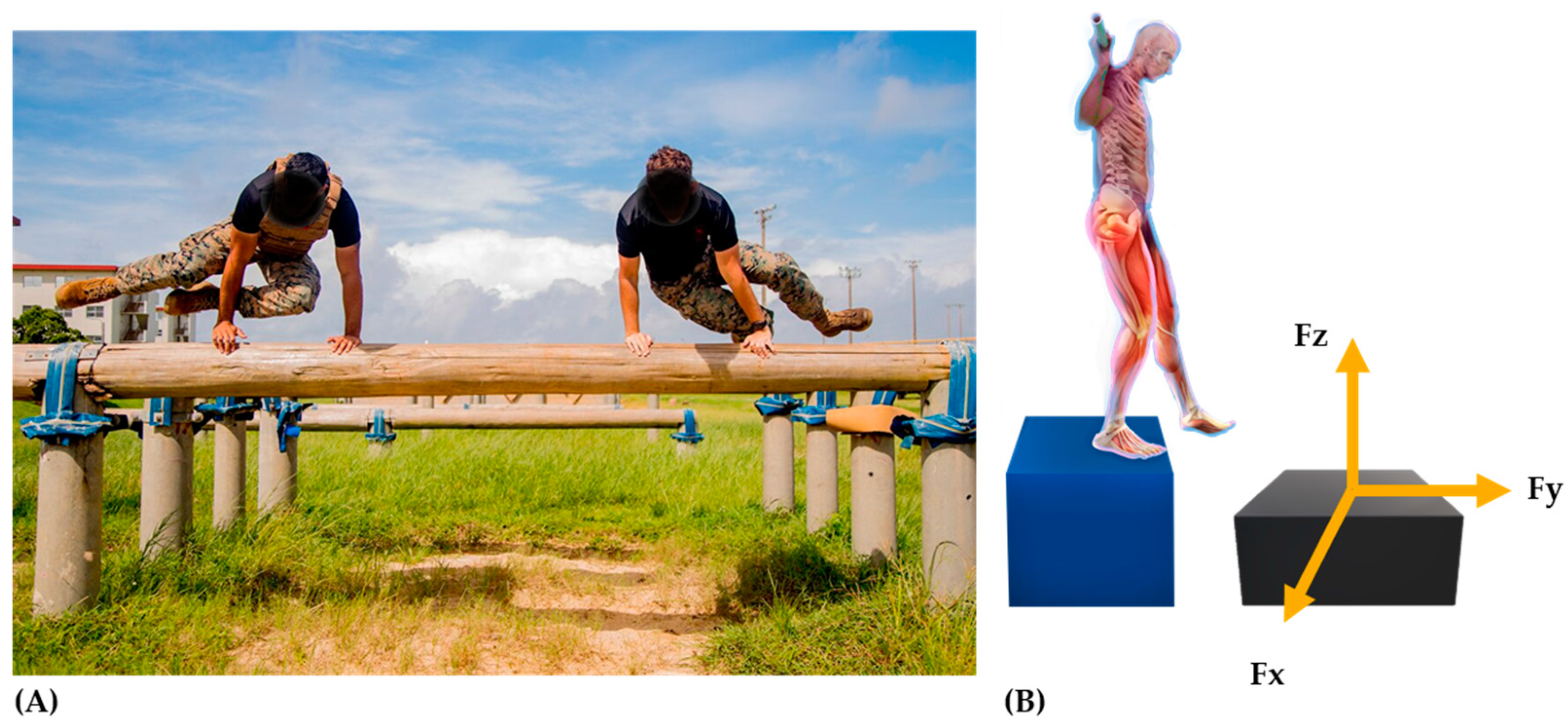
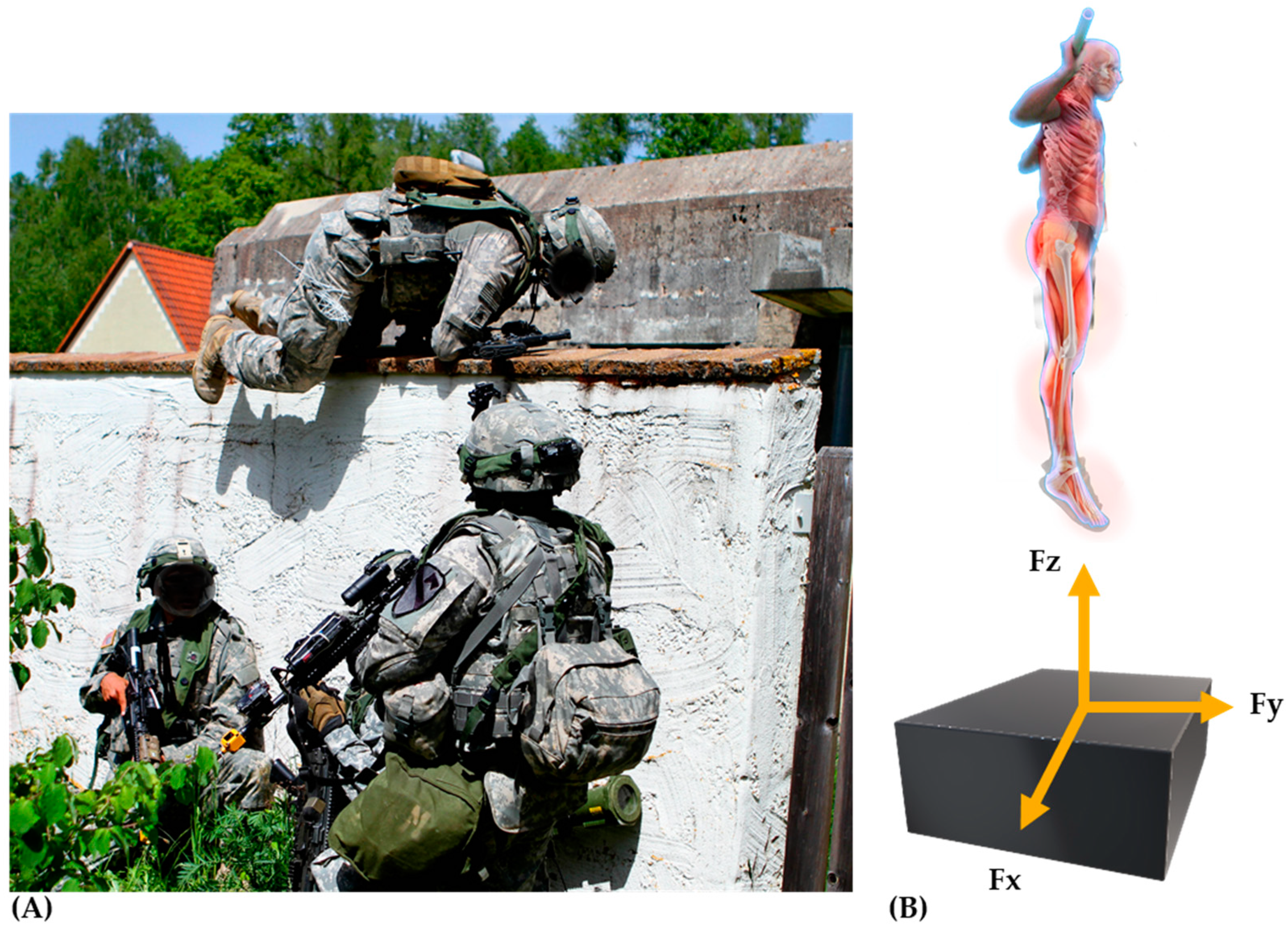
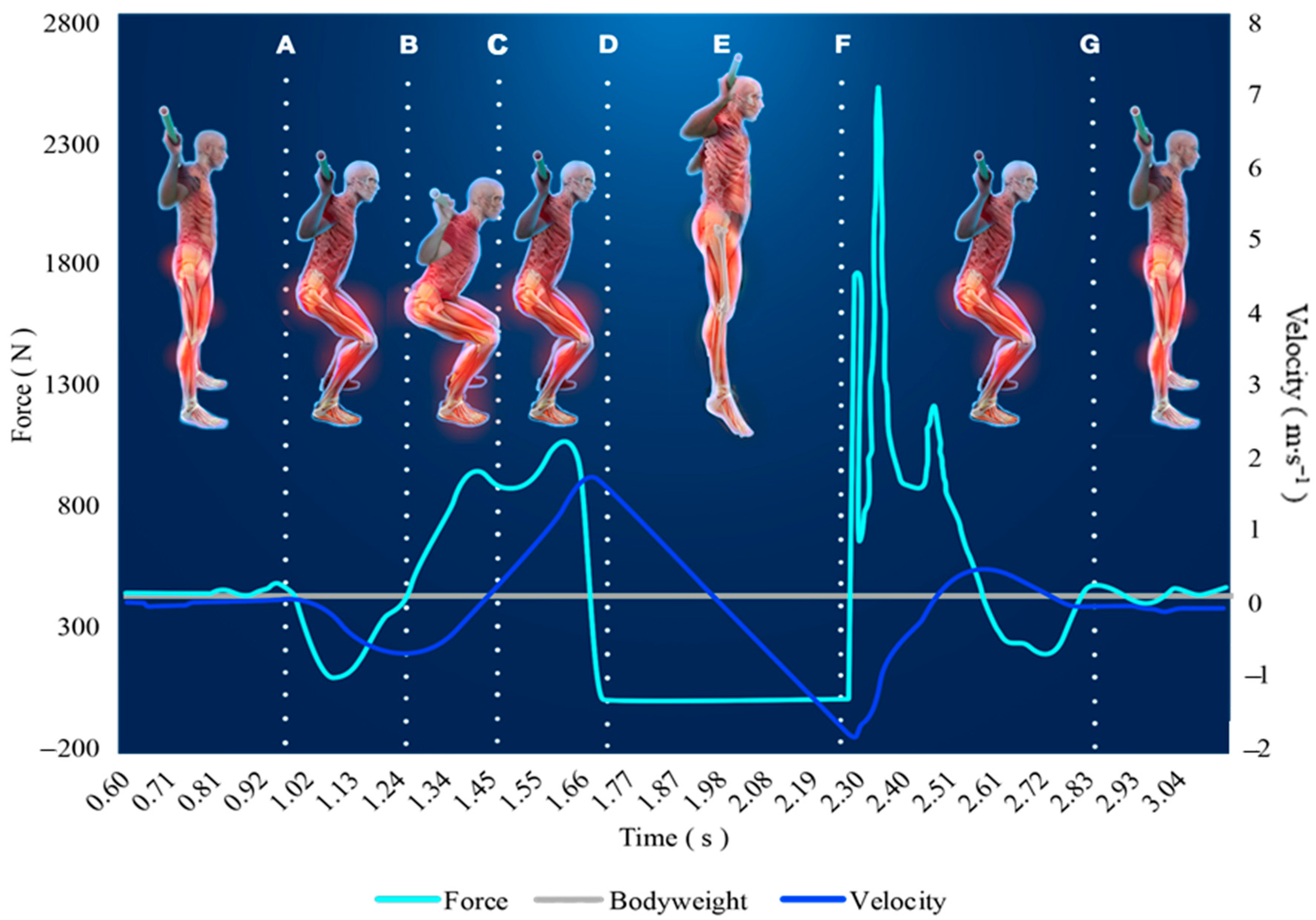
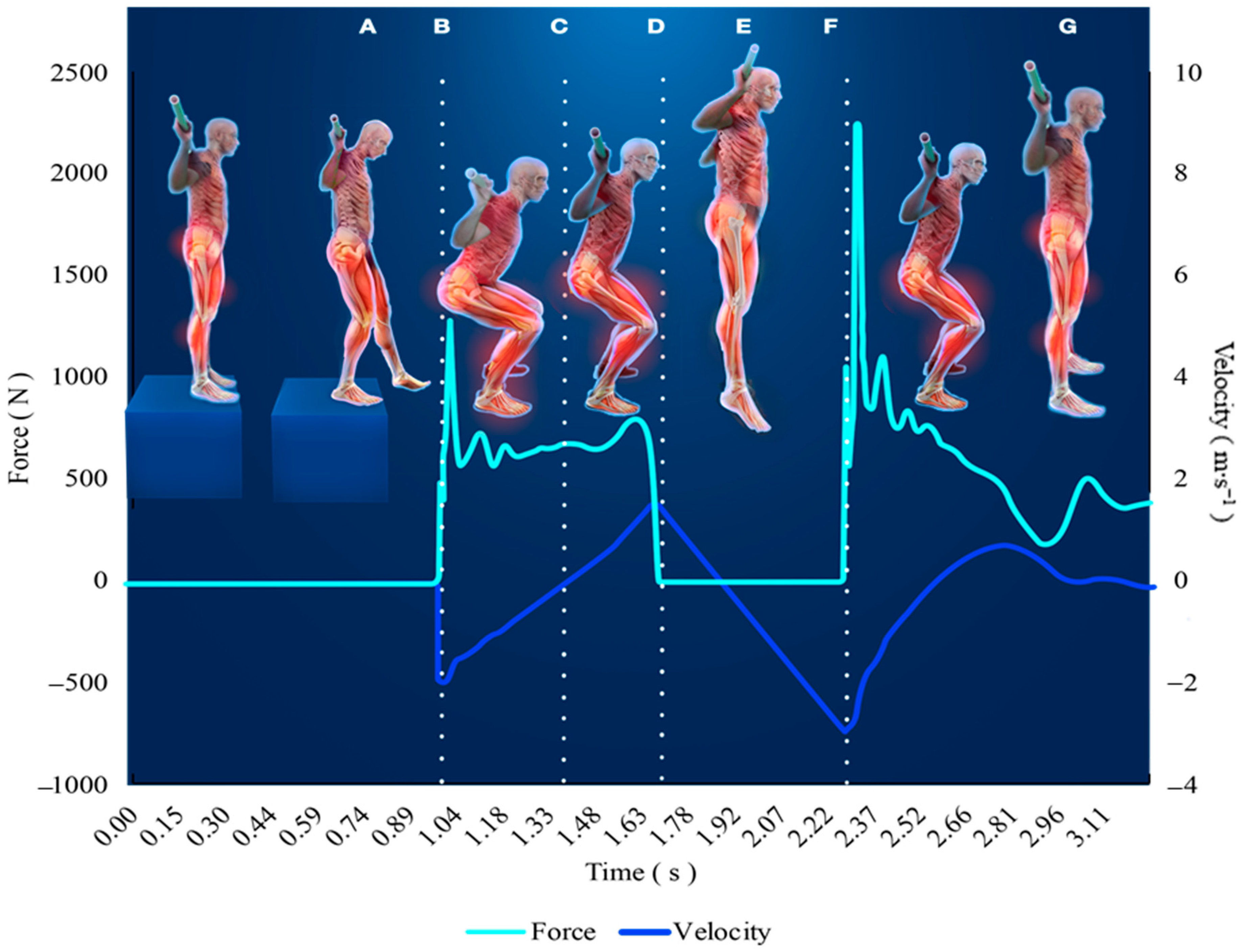
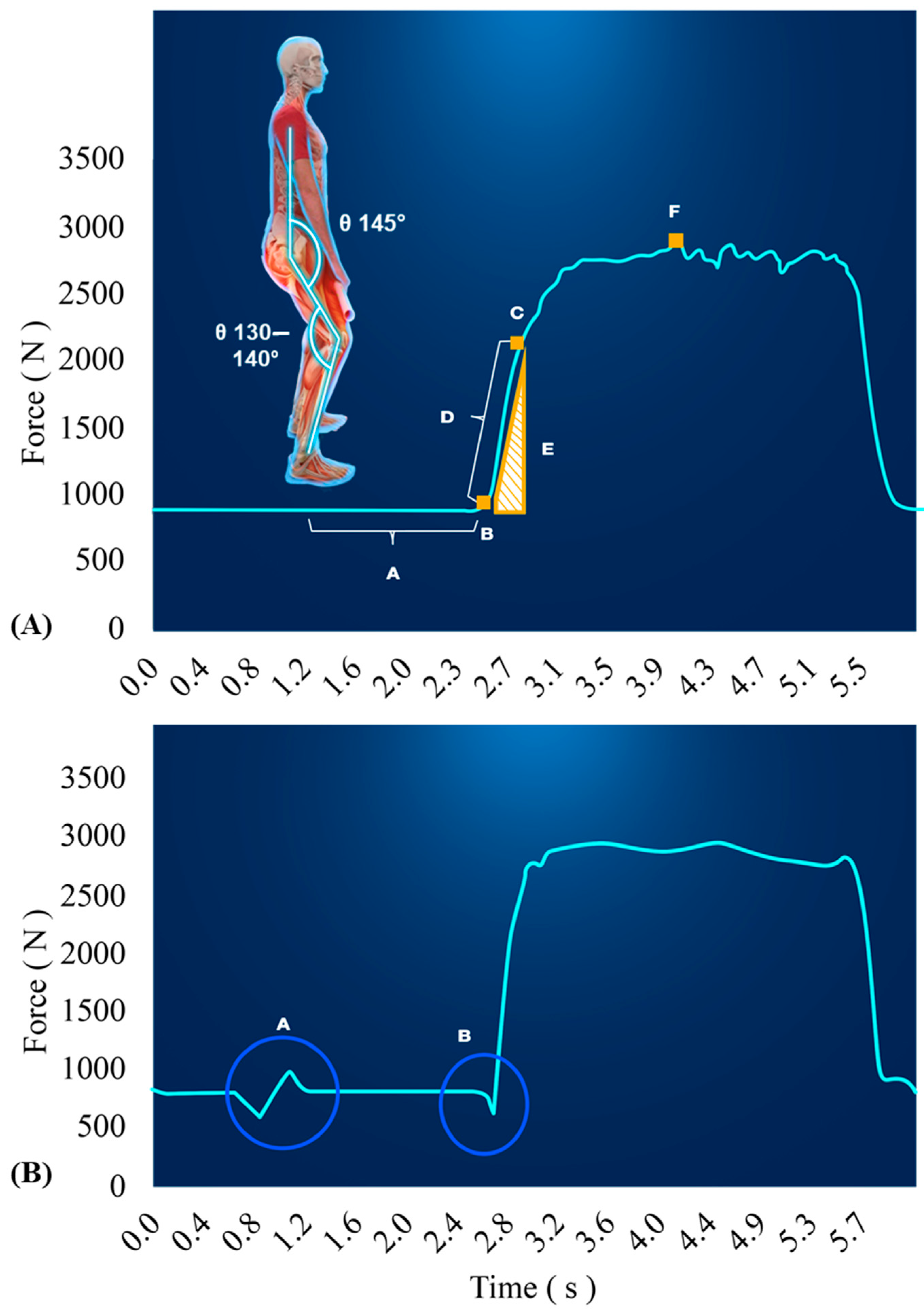
| Equipment |
|
| Movement |
|
| Data |
|
Publisher’s Note: MDPI stays neutral with regard to jurisdictional claims in published maps and institutional affiliations. |
© 2020 by the authors. Licensee MDPI, Basel, Switzerland. This article is an open access article distributed under the terms and conditions of the Creative Commons Attribution (CC BY) license (http://creativecommons.org/licenses/by/4.0/).
Share and Cite
Merrigan, J.J.; Stone, J.D.; Thompson, A.G.; Hornsby, W.G.; Hagen, J.A. Monitoring Neuromuscular Performance in Military Personnel. Int. J. Environ. Res. Public Health 2020, 17, 9147. https://doi.org/10.3390/ijerph17239147
Merrigan JJ, Stone JD, Thompson AG, Hornsby WG, Hagen JA. Monitoring Neuromuscular Performance in Military Personnel. International Journal of Environmental Research and Public Health. 2020; 17(23):9147. https://doi.org/10.3390/ijerph17239147
Chicago/Turabian StyleMerrigan, Justin J., Jason D. Stone, Andrew G. Thompson, W. Guy Hornsby, and Joshua A. Hagen. 2020. "Monitoring Neuromuscular Performance in Military Personnel" International Journal of Environmental Research and Public Health 17, no. 23: 9147. https://doi.org/10.3390/ijerph17239147
APA StyleMerrigan, J. J., Stone, J. D., Thompson, A. G., Hornsby, W. G., & Hagen, J. A. (2020). Monitoring Neuromuscular Performance in Military Personnel. International Journal of Environmental Research and Public Health, 17(23), 9147. https://doi.org/10.3390/ijerph17239147







